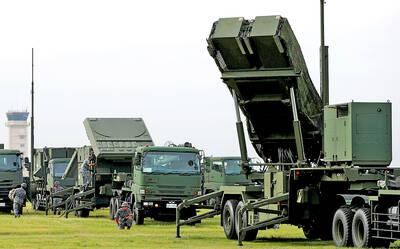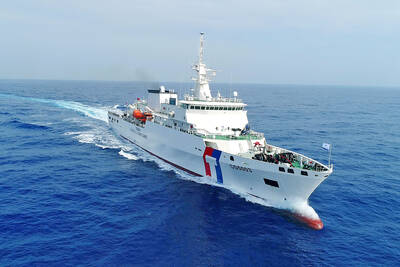The Ministry of Education's announcement on Wednesday to adopt Tongyong Pinyin (通用拼音) as the nation's standardized Romanization system for Man-darin has increased tensions between the central and Taipei City governments.
Taipei Mayor Ma Ying-jeou (
Ma insisted that Hanyu Pinyin (
Tongyong Pinyin is about 85 percent similar to Hanyu Pinyin.
"More than 85 percent of the 2.6 million visitors who come to Taiwan visit Taipei," Ma said. "The need for globalization in the capital is more urgent than anywhere else. Taipei City must adopt Hanyu Pinyin."
To show respect for the education ministry's decision, Ma said both systems will be used on streets connecting the city to outside areas. Hanyu Pinyin will appear first, with Tongyong Pinyin added underneath in parentheses.
The Mandarin Promotion Council, a task force under the education ministry, decided two days ago to choose the Tongyong system. While the council has made a decision, the controversy surrounding the Romanization debate isn't likely to end.
The council voted 10 to zero in support of Tongyong Pinyin. But 16 members of the 26-person panel did not cast ballots. Reports said many of the members who supported Hanyu Pinyin skipped the meeting because a decision in favor of Tongyong Pinyin seemed a fait accompli.
Backers of Hanyu Pinyin support the system because of its prevalent use overseas. But Tongyong Pinyin advocates say the system preserves Taiwan's cultural sovereignty and accommodates sounds in the Hokkien, Hakka and Aboriginal languages.
"If Taiwan adopts the Hanyu Pinyin system used in China, Taiwan will lose its unique cultural traits and national identity," said Yu Bor-chuan (余伯泉), an associate researcher at the Institute of Ethnology at Academia Sinica and the leader of the team which invented the Tongyong Pinyin system in 1998. "It would be an irreparable loss."
Minister of Education Huang Jong-tsun (
With the exception of Taipei City, many governments including Kaohsiung City and Taipei County have agreed to adopt Tongyong Pinyin.
Huang added the central government hopes to develop techniques and codes so that the two systems are understood by computers. The education minister also acknowledged the "political sentiments" held by supporters of either system. Indeed, one KMT lawmaker charged that the policy supporting Tongyong was part of the DPP's efforts to "split Taiwan from the mainland."
Asked whether the needs of foreigners were taken into account when choosing the system, Huang said "foreigners will solve the question themselves."
Chen Chi-nan (
He said only very few foreigners who understand Mandarin know the differences between Tongyong and Hanyu, given that Hanyu is the system used overseas for Mandarin study.
Chen argued that for most foreigners, what's most important is that street signs use consistent spelling and are easy to read.
"The most important issue is consistency," he said. "There wouldn't be a problem if street signs were spelled consistently everywhere in the nation."

MILITARY BOOST: The procurement was planned after Washington recommended that Taiwan increase its stock of air defense missiles, a defense official said yesterday Taiwan is planning to order an additional four PAC-3 MSE systems and up to 500 missiles in response to an increasing number of missile sites on China’s east coast, a defense official said yesterday. The official, who spoke on condition of anonymity, said that the proposed order would be placed using the defense procurement special budget, adding that about NT$1 trillion (US$32,88 billion) has been allocated for the budget. The proposed acquisition would include launchers, missiles, and a lower tier air and missile defense radar system, they said The procurement was planned after the US military recommended that Taiwan increase

POLITICAL AGENDA: Beijing’s cross-strait Mid-Autumn Festival events are part of a ‘cultural united front’ aimed at promoting unification with Taiwan, academics said Local authorities in China have been inviting Taiwanese to participate in cross-strait Mid-Autumn Festival celebrations centered around ideals of “family and nation,” a move Taiwanese academics said politicizes the holiday to promote the idea of “one family” across the Taiwan Strait. Sources said that China’s Fujian Provincial Government is organizing about 20 cross-strait-themed events in cities including Quanzhou, Nanping, Sanming and Zhangzhou. In Zhangzhou, a festival scheduled for Wednesday is to showcase Minnan-language songs and budaixi (布袋戲) glove puppetry to highlight cultural similarities between Taiwan and the region. Elsewhere, Jiangsu Province is hosting more than 10 similar celebrations in Taizhou, Changzhou, Suzhou,

TWO HEAVYWEIGHTS: Trump and Xi respect each other, are in a unique position to do something great, and they want to do that together, the US envoy to China said The administration of US President Donald Trump has told Chinese President Xi Jinping (習近平) “we don’t want any coercion, but we want [the Taiwan dispute] resolved peacefully,” US ambassador to China David Perdue said in a TV interview on Thursday. Trump “has said very clearly, we are not changing the ‘one China’ policy, we are going to adhere to the Taiwan Relations Act, the three communiques and the ‘six assurances’ that were done under [former US president Ronald] Reagan,” Perdue told Joe Kernen, cohost of CNBC’s Squawk Box. The act, the Three Joint Communiques and the “six assurances” are guidelines for Washington

DEEPENING TIES: The two are boosting cooperation in response to China’s coercive actions and have signed MOUs on search-and-rescue and anti-smuggling efforts Taiwan and Japan are moving to normalize joint coast guard training and considering the inclusion of other allies, the Japanese Yomiuri Shimbun reported yesterday. Both nations’ coast guards in June sent vessels to the seas south of the Sakishima Islands to conduct joint training, the report said, adding that it was the second joint maritime training exercise since the nations severed formal diplomatic ties in September 1972. Japan dispatched the Nagoya Coast Guard’s Mizuho, a 134m, 6,000-tonne patrol vessel which can carry a helicopter, while the Coast Guard Administration (CGA) sent the 126m, 4,000-tonne Yunlin, one of its largest vessels, the report